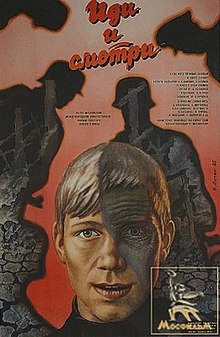| Come and See | |
|---|---|
 Russian theatrical release poster | |
| Directed by | Elem Klimov |
| Screenplay by |
|
| Starring |
|
| Cinematography | Aleksei Rodionov |
| Edited by | Valeriya Belova |
| Music by | Oleg Yanchenko |
Production companies | |
| Distributed by | Sovexportfilm |
Release date |
|
Running time | 142 minutes[1] |
| Country | Soviet Union[2] |
| Languages |
|
| Box office | $21 million[3] |
Come and See (Russian: Иди и смотри, romanized: Idi i smotri; Belarusian: Ідзі і глядзі, romanized: Idzi i hliadzi; meaning ‘go and see’) is a 1985 Soviet anti-war film directed by Elem Klimov and starring Aleksei Kravchenko and Olga Mironova.[4] Its screenplay, written by Klimov and Ales Adamovich, is based on the 1971 novel Khatyn[5] and the 1977 collection of survivor testimonies I Am from the Fiery Village[6] (Я из огненной деревни, Ya iz ognennoy derevni),[7] of which Adamovich was a co-author.[8] Klimov had to fight eight years of censorship from the Soviet authorities before he was allowed to produce the film in its entirety.[9][10]
The film's plot focuses on the Nazi German occupation of Belarus, and the events as witnessed by a young teenager named Flyora, who joins the Belarusian partisans, and thereafter depicts the Nazi atrocities and human suffering inflicted upon the populace. The film mixes hyper-realism with an underlying surrealism, and philosophical existentialism with poetical, psychological, political and apocalyptic themes.
Come and See received widespread acclaim upon release with Kravchenko's performance being universally lauded (and highly regarded as one of the finest instances of child acting ever), and received the FIPRESCI prize at the 14th Moscow International Film Festival. It has since come to be considered one of the greatest films of all time; in the 2022 Sight & Sound directors' poll of the Greatest Films of all Time, it ranked 41st.[11]
- ^ "Come and See (15)". British Board of Film Classification. 16 December 1986. Retrieved 29 May 2013.
- ^ "IDI I SMOTRI (1985)". British Film Institute. Archived from the original on 11 February 2016. Retrieved 5 December 2018.
- ^ "Come and See (1985)". Box Office Mojo. IMDbPro. Retrieved 22 December 2020.
- ^ Cite error: The named reference
RTwas invoked but never defined (see the help page). - ^ Mort, Valzhyna (30 June 2020). "Read and See: Ales Adamovich and Literature out of Fire". The Criterion Collection. Retrieved 1 September 2022.
- ^ Chapman, James (2008). "Chapter 2 war as tragedy (pp. 103ff.)". War and Film. Islington: Reaktion Books. ISBN 978-1-86189347-5.
- ^ Адамович, Алесь [Adamovich, Ales]; Брыль, Янка [Visor, Vanya]; Калесник, Уладзимир Андрэевич [Kalesnik, Uladimir Andreevich] (1977). Я из огненной деревни... [I Am from the Fiery Village...] (in Belarusian). Minsk: Мастацкая лит-ра [Art lit-ra].
{{cite book}}: CS1 maint: multiple names: authors list (link) CS1 maint: numeric names: authors list (link) - ^ Rein, Leonid (2011). The Kings and the Pawns. Collaboration in Byelorussia during World War II. New York City: Berghahn Books. ISBN 978-0-85745043-2.
The stories of survivors from the burned villages were collected in the 1970s by three Byelorussian writers, Ales' Adamovich, Janka Bryl', and Vladimir Kolesnik and published as a book in Russian and Byelorussian under the title Ya iz ognennoj derevni ... [I am from the fiery village]. See Adamovich et al., Ya iz ognennoj derevni ... (Minsk, 1977).
- ^ Марина Мурзина [Marina Murzina] (20 October 2010). Иди и смотри: съёмки превратились для Элема Климова в борьбу с цензурой [Come and See: filming turned for Elem Klimov into fight against censorship]. Аргументы и факты [Arguments and Facts] (in Russian). No. 42. Retrieved 30 August 2016.
- ^ Cite error: The named reference
DJYwas invoked but never defined (see the help page). - ^ "Directors' 100 Greatest Films of All Time". BFI. Retrieved 1 December 2022.